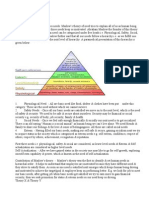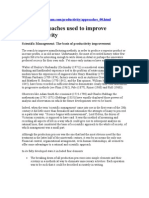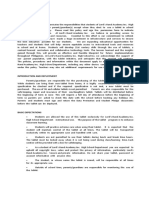Theory of Management
Theory of Management
Uploaded by
Umme KulsumCopyright:
Available Formats
Theory of Management
Theory of Management
Uploaded by
Umme KulsumCopyright
Available Formats
Share this document
Did you find this document useful?
Is this content inappropriate?
Copyright:
Available Formats
Theory of Management
Theory of Management
Uploaded by
Umme KulsumCopyright:
Available Formats
What is Elton Mayo's Human Relations Theory?
Elton Mayo developed the Human Relations Theory of Management. Mayo was
known for his book “The Human Problems of an Industrialized Civilization (1933)
and Hawthorne Studies. In Elton Mayo theory of human relations, he states that
employees are motivated more by relational factors like camaraderie and attention
than environmental factors like humidity, lighting, etc., and monetary rewards. Elton
Mayo developed a milieu that he used to define the possibility that assigned tasks
will be completed successfully by the team.
In this blog, we described Elton Mayo’s Human Relations Theory. This blog talks
about the basics of this management tool. Let’s begin!
Understand the “Human Relations Theory of
Management” Developed by Elton Mayo’s
Elton Mayo has made an important role in management theory that helped make
preparations for the modern human relations management approach.
Mayo’s human relations theory was based on his Hawthorne experiments. Mayo's
theory was based on his employee observations of productivity levels under different
environmental conditions. His experiments described different conclusions about
the source of employee motivation. Mayo’s management theory describes that team
members are motivated by relational factors like camaraderie and attention than by
environmental factors and monetary rewards such as humidity, lighting, etc. as we
have discussed in the first paragraph.
Elton Mayo created a matrix that is being used to define the likelihood that ensures
that the assigned task to a team can successfully complete the task. The matrix
developed by Mayo explains the role that combines several group cohesiveness and
group norms maximum the effectiveness of the team.
Here are a few combinations of Mayo theory and its effect
on team dynamics:
• According to Mayo's theory, groups with low cohesiveness and low norms are
ineffective with no impact, since no members are motivated to excel.
• Groups having high cohesiveness and low norms have negative impacts since
team members buoy up negative behaviour.
• Groups that have low cohesiveness and high norms have a few positive
effects through individual member actions.
• Groups with high cohesiveness and high norms come with the greatest
positive impact. Elton Mayo's Human Relation Approach to Management
theory envisages that group members reassure to excel each other.
How George Elton Mayo Contributed to Management?
George Elton Mayo was a professor who published the book – Human Problems of
an Industrial Civilisation in 1933, Social problems of an Industrial Civilisation in 1945,
Training for Human Relations 1949 et cetera. He also conducted “Hawthorne
Experiments” during 1927-1932. Experiments are illustrated below –
• Illumination Experiments: Under this experiment, it was known that
productivity can be maximized not only by developing a proper work
environment, but also by informal social relations between teams.
• Relay Assembly Test Room Experiment: Here, a homogeneous working team
was constituted where different elements were introduced, such as—proper
rest periods, shorter working hours, friendly supervision, improved physical
conditions, free social interaction, etc. At the time of the experiment, morale
and productivity increased. Morale and productivity were maintained even
when improvements were withdrawn even in the working conditions. The
experts come to conclude that socio-psychological factors like recognition,
feelings of being important, informal work group, participation, non-directive
supervision, and so on are the key factors for higher productivity.
• Mass Interviewing Programme In this programme, several workers were
interviewed in order to know their orientation and perceptions on the working
life. The outcome again says that informal relation information, social, and
psychological needs impact the workers’ behaviour.
• Bank Wiring Observation Room Experiment In this experiment, 14 workers
were observed depending on their work behaviour. As a result, it was revealed
the informal production norms were formulated by the workers, and also the
existence of the informal relation was seen.
Reading: McGregor’s Theory X and Theory Y
The idea that a manager’s attitude has an impact on employee motivation was
originally proposed by Douglas McGregor, a management professor at the
Massachusetts Institute of Technology during the 1950s and 1960s. In his 1960
book, The Human Side of Enterprise, McGregor proposed two theories by which
managers perceive and address employee motivation. He referred to these opposing
motivational methods as Theory X and Theory Y management. Each assumes that
the manager’s role is to organize resources, including people, to best benefit the
company. However, beyond this commonality, the attitudes and assumptions they
embody are quite different.
Theory X
According to McGregor, Theory X management assumes the following:
• Work is inherently distasteful to most people, and they will attempt to avoid
work whenever possible.
• Most people are not ambitious, have little desire for responsibility, and prefer to
be directed.
• Most people have little aptitude for creativity in solving organizational
problems.
• Motivation occurs only at the physiological and security levels of Maslow’s
hierarchy of needs.
• Most people are self-centered. As a result, they must be closely controlled and
often coerced to achieve organizational objectives.
• Most people resist change.
• Most people are gullible and unintelligent.
Essentially, Theory X assumes that the primary source of employee motivation is
monetary, with security as a strong second. Under Theory X, one can take a hard or
soft approach to getting results.
The hard approach to motivation relies on coercion, implicit threats,
micromanagement, and tight controls— essentially an environment of command and
control. The soft approach, however, is to be permissive and seek harmony in the
hopes that, in return, employees will cooperate when asked. However, neither of
these extremes is optimal. The hard approach results in hostility, purposely low
output, and extreme union demands. The soft approach results in a growing desire
for greater reward in exchange for diminished work output.
It might seem that the optimal approach to human resource management would lie
somewhere between these extremes. However, McGregor asserts that neither
approach is appropriate, since the basic assumptions of Theory X are incorrect.
Drawing on Maslow’s hierarchy of needs, McGregor argues that a need, once
satisfied, no longer motivates. The company uses monetary rewards and benefits to
satisfy employees’ lower-level needs. Once those needs have been satisfied, the
motivation disappears. Theory X management hinders the satisfaction of higher-level
needs because it doesn’t acknowledge that those needs are relevant in the
workplace. As a result, the only way that employees can attempt to meet higher-level
needs at work is to seek more compensation, so, predictably, they focus on
monetary rewards. While money may not be the most effective way to self-fulfillment,
it may be the only way available. People will use work to satisfy their lower needs
and seek to satisfy their higher needs during their leisure time. However, employees
can be most productive when their work goals align with their higher-level needs.
McGregor makes the point that a command-and-control environment is not effective
because it relies on lower needs for motivation, but in modern society those needs
are mostly satisfied and thus are no longer motivating. In this situation, one would
expect employees to dislike their work, avoid responsibility, have no interest in
organizational goals, resist change, etc.—creating, in effect, a self-fulfilling prophecy.
To McGregor, a steady supply of motivation seemed more likely to occur
under Theory Y management.
Theory Y
The higher-level needs of esteem and self-actualization are ongoing needs that, for
most people, are never completely satisfied. As such, it is these higher-level needs
through which employees can best be motivated.
In strong contrast to Theory X, Theory Y management makes the following
assumptions:
• Work can be as natural as play if the conditions are favorable.
• People will be self-directed and creative to meet their work and organizational
objectives if they are committed to them.
• People will be committed to their quality and productivity objectives if rewards
are in place that address higher needs such as self-fulfillment.
• The capacity for creativity spreads throughout organizations.
• Most people can handle responsibility because creativity and ingenuity are
common in the population.
• Under these conditions, people will seek responsibility.
Under these assumptions, there is an opportunity to align personal goals with
organizational goals by using the employee’s own need for fulfillment as the
motivator. McGregor stressed that Theory Y management does not imply a soft
approach.
McGregor recognized that some people may not have reached the level of maturity
assumed by Theory Y and may initially need tighter controls that can be relaxed as
the employee develops.
If Theory Y holds true, an organization can apply the following principles of scientific
management to improve employee motivation:
• Decentralization and delegation: If firms decentralize control and reduce the
number of levels of management, managers will have more subordinates and
consequently need to delegate some responsibility and decision making to
them.
• Job enlargement: Broadening the scope of an employee’s job adds variety
and opportunities to satisfy ego needs.
• Participative management: Consulting employees in the decision-making
process taps their creative capacity and provides them with some control over
their work environment.
• Performance appraisals: Having the employee set objectives and participate
in the process of self-evaluation increases engagement and dedication.
If properly implemented, such an environment can increase and continually
fuel motivation as employees work to satisfy their higher-level personal needs
through their jobs.
Ouchi’s Theory Z
During the 1980s, American business and industry experienced a tsunami of
demand for Japanese products and imports, particularly in the automotive industry.
Why were U.S. consumers clambering for cars, televisions, stereos, and electronics
from Japan? Two reasons: (1) high-quality products and (2) low prices. The
Japanese had discovered something that was giving them the competitive edge. The
secret to their success was not what they were producing but how they were
managing their people—Japanese employees were engaged, empowered, and
highly productive.
Management professor William Ouchi argued that Western organizations could
learn from their Japanese counterparts. Although born and educated in America,
Ouchi was of Japanese descent and spent a lot of time in Japan studying the
country’s approach to workplace teamwork and participative management. The
result was Theory Z—a development beyond Theory X and Theory Y that blended
the best of Eastern and Western management practices. Ouchi’s theory first
appeared in his 1981 book, Theory Z: How American Management Can Meet the
Japanese Challenge. The benefits of Theory Z, Ouchi claimed, would be reduced
employee turnover, increased commitment, improved morale and job satisfaction,
and drastic increases in productivity.
Theory Z stresses the need to help workers become generalists, rather than
specialists. It views job rotations and continual training as a means of increasing
employees’ knowledge of the company and its processes while building a variety of
skills and abilities. Since workers are given much more time to receive training,
rotate through jobs, and master the intricacies of the company’s operations,
promotions tend to be slower. The rationale for the drawn-out time frame is that it
helps develop a more dedicated, loyal, and permanent workforce, which benefits the
company; the employees, meanwhile, have the opportunity to fully develop their
careers at one company. When employees rise to a higher level of management, it is
expected that they will use Theory Z to “bring up,” train, and develop other
employees in a similar fashion.
Ouchi’s Theory Z makes certain assumptions about workers. One assumption is that
they seek to build cooperative and intimate working relationships with their
coworkers. In other words, employees have a strong desire for affiliation. Another
assumption is that workers expect reciprocity and support from the company.
According to Theory Z, people want to maintain a work-life balance, and they value a
working environment in which things like family, culture, and traditions are
considered to be just as important as the work itself. Under Theory Z management,
not only do workers have a sense of cohesion with their fellow workers, they also
develop a sense of order, discipline, and a moral obligation to work hard. Finally,
Theory Z assumes that given the right management support, workers can be trusted
to do their jobs to their utmost ability and look after for their own and others’ well-
being.
Theory Z also makes assumptions about company culture. If a company wants to
realize the benefits described above, it needs to have the following:
• A strong company philosophy and culture: The company philosophy and
culture need to be understood and embodied by all employees, and employees
need to believe in the work they’re doing.
• Long-term staff development and employment: The organization and
management team need to have measures and programs in place to develop
employees. Employment is usually long-term, and promotion is steady and
measured. This leads to loyalty from team members.
• Consensus in decisions: Employees are encouraged and expected to take
part in organizational decisions.
• Generalist employees: Because employees have a greater responsibility in
making decisions and understand all aspects of the organization, they ought
to be generalists. However, employees are still expected to have specialized
career responsibilities.
• Concern for the happiness and well-being of workers: The organization
shows sincere concern for the health and happiness of its employees and their
families. It takes measures and creates programs to help foster this happiness
and well-being.
• Informal control with formalized measures: Employees are empowered to
perform tasks the way they see fit, and management is quite hands-off.
However, there should be formalized measures in place to assess work quality
and performance.
• Individual responsibility: The organization recognizes individual contributions
but always within the context of the team as a whole.
Theory Z is not the last word on management, however, as it does have its
limitations. It can be difficult for organizations and employees to make lifetime
employment commitments. Also, participative decision-making may not always be
feasible or successful due to the nature of the work or the willingness of the workers.
Slow promotions, group decision-making, and lifetime employment may not be a
good fit with companies operating in cultural, social, and economic environments
where those work practices are not the norm.
You might also like
- SS1 Data Processing ExaminationDocument4 pagesSS1 Data Processing ExaminationEjiro Ndifereke80% (5)
- Theory X and Theory YDocument20 pagesTheory X and Theory Yhanizzz67% (3)
- Theories of MotivationDocument53 pagesTheories of MotivationNakitare W. Erick100% (1)
- Pressure Loss Equations PDFDocument18 pagesPressure Loss Equations PDFcperez10000No ratings yet
- Common Law Trusts As Business EnterprisesDocument33 pagesCommon Law Trusts As Business EnterprisesTiger Dimension-El100% (15)
- Struthers, J. Keith-Clinical Microbiology-CRC Press (2018)Document299 pagesStruthers, J. Keith-Clinical Microbiology-CRC Press (2018)Rosantia Sarassari100% (8)
- McGregor's Theory X and Theory YDocument6 pagesMcGregor's Theory X and Theory YtubenaweambroseNo ratings yet
- Theory X Y ZDocument6 pagesTheory X Y ZNooray MalikNo ratings yet
- Theory X & YDocument35 pagesTheory X & YKeefe Andrei AgnoNo ratings yet
- Model Paper O.B.Document10 pagesModel Paper O.B.kodakcamera1986No ratings yet
- MGT Question-AnswerDocument37 pagesMGT Question-AnswerSumaya ImamNo ratings yet
- THEORIES OF MOTIVATION BoDocument7 pagesTHEORIES OF MOTIVATION Bosakalasandra3No ratings yet
- Motivation, Employee 3333Document31 pagesMotivation, Employee 3333Mark Kenneth MirandillaNo ratings yet
- Introduction To Management Chapter Six 6. The Leading/Directing Function Chapter ObjectivesDocument15 pagesIntroduction To Management Chapter Six 6. The Leading/Directing Function Chapter ObjectivesfitsumNo ratings yet
- Theories of Motivation ObDocument11 pagesTheories of Motivation ObMartha Kayumba SakalaNo ratings yet
- Definition of Theory X and Theory YDocument9 pagesDefinition of Theory X and Theory YRashmii BoppunaNo ratings yet
- Theory of Needs: Q. No. 3 (Word Limit: 200 Words) A) Enumerate Mcclelland S Achievement Motivation TheoryDocument9 pagesTheory of Needs: Q. No. 3 (Word Limit: 200 Words) A) Enumerate Mcclelland S Achievement Motivation TheorySatyabrat DasNo ratings yet
- The Limitations of Theory X and Theory YDocument9 pagesThe Limitations of Theory X and Theory Yfieya9150% (6)
- Behavioral Management TheoryDocument25 pagesBehavioral Management TheoryGilbey Clark Libres100% (1)
- Educational Management of Yesterday and TodayDocument14 pagesEducational Management of Yesterday and TodayMichaela Elaine MonteNo ratings yet
- Litreature ReviewDocument5 pagesLitreature ReviewAmanda PowellNo ratings yet
- ObDocument28 pagesObsambhu_nNo ratings yet
- Report On Motivation Theories: Organizational Behavior Course Code: MGT 201 Section: 02Document12 pagesReport On Motivation Theories: Organizational Behavior Course Code: MGT 201 Section: 02i CrYNo ratings yet
- Case Study-CosicoDocument9 pagesCase Study-CosicopororogirlNo ratings yet
- "Theories" Regarding The Basic Nature of People. Mcgregor Proposed That The Way in WhichDocument4 pages"Theories" Regarding The Basic Nature of People. Mcgregor Proposed That The Way in WhichHikmah HamdanNo ratings yet
- Theories of MotivationDocument5 pagesTheories of MotivationjithuNo ratings yet
- Theories in HBO: PMEDL Class April 10, 2021Document23 pagesTheories in HBO: PMEDL Class April 10, 2021Cindy Ortiz GastonNo ratings yet
- Management TheoriesDocument19 pagesManagement TheoriesYASH VERMANo ratings yet
- Assignment On Semester Final Exam..2Document9 pagesAssignment On Semester Final Exam..2Twasin WaresNo ratings yet
- Mary Grace R. Abrena, RL Shailaris Nul AbdulDocument5 pagesMary Grace R. Abrena, RL Shailaris Nul AbdulNaima Utto AbdulkarimNo ratings yet
- 204 Organization and ManagementDocument10 pages204 Organization and ManagementChristy AnnNo ratings yet
- 9735 Task 2Document11 pages9735 Task 2Sam JairathNo ratings yet
- Theory X and Theory YDocument6 pagesTheory X and Theory Ykim cheNo ratings yet
- Human Relations Domain: Organizational Theory Suzanne Beaumaster, PH.DDocument24 pagesHuman Relations Domain: Organizational Theory Suzanne Beaumaster, PH.DSuzanne BeaumasterNo ratings yet
- Employee Motivation of Grameenphone Theory and PracticeDocument26 pagesEmployee Motivation of Grameenphone Theory and PracticeMahmud Jubaer50% (2)
- Management Strategies in Educational InstitutionsDocument16 pagesManagement Strategies in Educational InstitutionsGhulam ShabbirNo ratings yet
- Theory X: The Hard Approach Results in HostilityDocument3 pagesTheory X: The Hard Approach Results in HostilityMoad AmimerNo ratings yet
- Basic Management Theory Frederick Taylor - Scientific ManagementDocument4 pagesBasic Management Theory Frederick Taylor - Scientific ManagementNathanael ReyesNo ratings yet
- Elton Mayo's Human Relations ApproachDocument15 pagesElton Mayo's Human Relations ApproachYoNo ratings yet
- Behavioral Management MPA 202Document18 pagesBehavioral Management MPA 202Aldrich FloresNo ratings yet
- Industrial M NotesDocument21 pagesIndustrial M NotesimnithinNo ratings yet
- Theorist TemplateDocument5 pagesTheorist TemplateSahil MehtaNo ratings yet
- Oc 3 - HRDocument20 pagesOc 3 - HRSeemar Babar 512-FSS/MSMC/F22No ratings yet
- MC Gregors Theory X & yDocument5 pagesMC Gregors Theory X & yAndrew OlaguerNo ratings yet
- Theories of Motivation - SummaryDocument8 pagesTheories of Motivation - SummaryCharles Arrais Rodrigues FilhoNo ratings yet
- Motivational Concepts Robbins OB15 IRCppt07Document45 pagesMotivational Concepts Robbins OB15 IRCppt07Mehdis90% (1)
- Thesis RevisedDocument49 pagesThesis RevisedJhudiel Carlo Andoy0% (1)
- Theory X and Y - MSDA1 - 05.11.2020Document3 pagesTheory X and Y - MSDA1 - 05.11.2020Alin ApostolescuNo ratings yet
- Theory X and yDocument4 pagesTheory X and ysinghhamir100% (1)
- Introduction To Management Part 2Document62 pagesIntroduction To Management Part 2Navruz KhakimovNo ratings yet
- OTB - Lecture Notes 3 - MotivationDocument13 pagesOTB - Lecture Notes 3 - Motivationadan awaleNo ratings yet
- Theory X Theory Y Summary by Khalil Ullah SafiDocument3 pagesTheory X Theory Y Summary by Khalil Ullah SafiKhalil Ullah SafiNo ratings yet
- Basic Approaches Used To Improve ProductivityDocument13 pagesBasic Approaches Used To Improve ProductivityAdeel JattNo ratings yet
- Human Relation Approach Theory G 2Document29 pagesHuman Relation Approach Theory G 2John ReyNo ratings yet
- OB (After MT)Document20 pagesOB (After MT)Ram KumarNo ratings yet
- People - Theories of MotivationDocument34 pagesPeople - Theories of MotivationSandra_Vunganayi_608No ratings yet
- Summary - MotivationDocument12 pagesSummary - MotivationdutzaNo ratings yet
- OB Chapter 4 (FOUR) PPTDocument14 pagesOB Chapter 4 (FOUR) PPTsolizasoli16No ratings yet
- Theory X&YDocument21 pagesTheory X&Yshubham rathodNo ratings yet
- The Evolution of Human Resource ManagementDocument17 pagesThe Evolution of Human Resource ManagementNicky John Doroca Dela MercedNo ratings yet
- Organizational Behavior - Our Inherent Power of Generalization Helps Us To Predict TheDocument19 pagesOrganizational Behavior - Our Inherent Power of Generalization Helps Us To Predict TheJay Mark EscondeNo ratings yet
- Understanding Human Behaviour in The WorkplaceFrom EverandUnderstanding Human Behaviour in The WorkplaceRating: 3 out of 5 stars3/5 (1)
- Tool+6 8 +Case+Study+-+M-PESA,+TanzaniaDocument18 pagesTool+6 8 +Case+Study+-+M-PESA,+Tanzaniaafzallodhi736No ratings yet
- Real EstateDocument11 pagesReal EstateBarbie BleuNo ratings yet
- Orig Business Plan - Isagani Crispy Pasta OriginalDocument17 pagesOrig Business Plan - Isagani Crispy Pasta OriginalGilbert FernandoNo ratings yet
- Harf Project PortfolioDocument11 pagesHarf Project Portfolioapi-525092858No ratings yet
- Data S5Document5 pagesData S5Achmad AmrullohNo ratings yet
- Qualities of A Good CounselorDocument5 pagesQualities of A Good CounselorJade Harris Colorje100% (2)
- Website For Salon AdminDocument2 pagesWebsite For Salon AdminRabbi AliNo ratings yet
- GSM Final 1Document48 pagesGSM Final 1gijoe007No ratings yet
- Mock Test MSDocument4 pagesMock Test MSrita sehgalNo ratings yet
- BBA SyllabusDocument3 pagesBBA SyllabusKiron KamruzzamanNo ratings yet
- China Jiangxi Hongda MedicalDocument1 pageChina Jiangxi Hongda MedicalUzair Ul GhaniNo ratings yet
- 164947.PhD Thesis Anita CericDocument300 pages164947.PhD Thesis Anita CericiggyNo ratings yet
- Test Certificate: FDA Registration #3006423386Document4 pagesTest Certificate: FDA Registration #3006423386LarryDCurtisNo ratings yet
- Dissertation AppsDocument5 pagesDissertation AppsPayPeopleToWritePapersNorman100% (1)
- Up9000 ManualDocument33 pagesUp9000 Manualho-faNo ratings yet
- For The Global Ocean Biogeochemistry Hindcast GLOBAL - REANALYSIS - BIO - 001 - 029Document17 pagesFor The Global Ocean Biogeochemistry Hindcast GLOBAL - REANALYSIS - BIO - 001 - 029lalogoroNo ratings yet
- Time The Obligation To Deliver It Arises. However, He ShallDocument5 pagesTime The Obligation To Deliver It Arises. However, He ShallKryzia RillorazaNo ratings yet
- 6 Pricing Understanding and Capturing Customer ValueDocument27 pages6 Pricing Understanding and Capturing Customer ValueShadi JabbourNo ratings yet
- Monterrosa 2019Document18 pagesMonterrosa 2019GERARDO TORRES RUIZNo ratings yet
- Specification For EquipmentsDocument6 pagesSpecification For EquipmentsChiranjivi KuthumiNo ratings yet
- Individual Development Plan Template RRCDocument3 pagesIndividual Development Plan Template RRCMark Dexter Mejia50% (2)
- 4796 PrattMap MTP PDFDocument1 page4796 PrattMap MTP PDFDen WoNo ratings yet
- Food Fraud Prevention Checklist - Food Surety LimitedDocument3 pagesFood Fraud Prevention Checklist - Food Surety LimitedJesús Oscar Viloria LamedaNo ratings yet
- 48 Garcia v. Robles Vda. de CaparasDocument3 pages48 Garcia v. Robles Vda. de CaparasKatrina Janine Cabanos-ArceloNo ratings yet
- PGP14 T3 HRM S1Document9 pagesPGP14 T3 HRM S1Aryan BokdeNo ratings yet
- Tablet Rules and RegulationDocument5 pagesTablet Rules and RegulationJess MataNo ratings yet

























































































